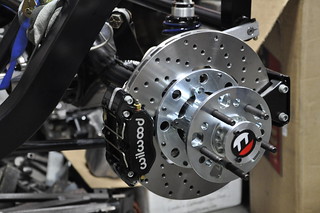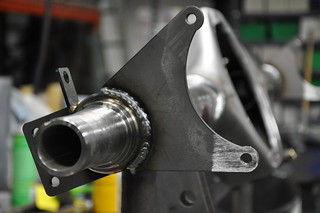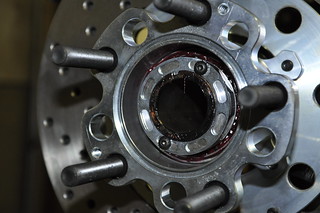Full Floating Rear End Advantages – Pro Touring
All Schwartz Performance G-Machine Chassis are equipped standard with a Moser full-floating 9-inch housing/hubs etc.
-Your stock rear end is a non-floating setup. Standard GM and Ford 8.8 axles are held in with C-clips at the center of the rear end. If the clip breaks or the axle shaft snaps, the wheel can fall off since it’d bolted to the axle.
-Standard 9-inch Ford axles are held in by a bearing & retainer at the outside end of the rear end housing. If an axle breaks, there’s still a chance that the wheel can fall off.
-Full floating axles like we supply are held in by nothing. That’s right, they literally float inside the rear end. The full floating axles are SPLINED on both ends, so they only DRIVE the wheel and do not support the weight of the vehicle. With that said, they are much safer!
The main advantage that we use them for in the pro-touring world is to eliminate brake pad “knock-back.”
The standard GM & Ford axles that have C-clips holding them in, the axle can move side to side a bit, especially when cornering. You don’t need to be cornering hard for this to occur.
On a bearing-retained axle like the standard Ford 9-inch, the axle is held a little better, but there is still deflection under hard corners.
Think about this:
-What bolts to a standard axle? The brake rotors and the wheels.
-What does your caliper bolt to then? The housing itself, which does not move.
-What happens when the axle deflects? Your rotor moves, but your caliper doesn’t- pushing your pads/pistons back into the caliper. Then the next time you go to hit the brakes, you need to pump them up to push the pads back out with the rotor.
Most upgraded calipers are fixed-mount. Some of the older 1 and 2-piston caliper designs are floating calipers, which have less of a tendency to push the pads back. On our G-Machine Chassis, we utilize a standard 4-piston Wilwood caliper, or the 6-piston Baer calipers which are both heavy duty fixed mount.
I still don’t get how the axle shaft works with the housing!
Think of your front spindle. It has a tapered snout that the bearings ride on, and the rotor fastens to. This is the same thing as a floating axle housing, but the spindle is large and hollow.
Here’s a picture of a bare housing with the “snout” or “spindle” welded on
Now here’s the hub assembly without the axle shaft or the splined drive plate installed. There’s a large nut that holds the bearings in, and a lock plate keeps it from loosening.
So why wouldn’t I want to go with a full-floating axle???
-Typically the cost is higher, but not by much. Our full floater adds only around $400 to the rear end cost, which isn’t much considering the advantages.
-Wheel fitment. A full floating setup has a large hub that sticks out from the wheel mounting surface. It is also a larger diameter. Some off-the-shelf cast wheels do not fit the floater very well, and either need the center bore machined larger, and/or a wheel spacer to allow the center cap to fit. If ordering custom wheels, you’ll need to specify the hub diameter & depth to be sure they fit.
-If you plan on upgrading the brake size down the road, there is cutting & welding required as the brake brackets are welded to the rear end housing. This is one of the reasons why we stick with a minimum of 13″ rotors, or 12″ if you’re using 15-16″ wheels.
Isn’t this a little overkill for my street car?
-If you’re never going to go around an exit ramp at an accelerated rate, run 7″ wide rear wheels, and have 250hp, yes.
-In all seriousness, full-floaters are becoming the norm in the pro-touring world, and offer more advantages than disadvantages. We’ve been using them as standard equipment since we started in 2005.
Can I get a full floater setup on anything other than a Ford 9-inch housing?
-YES! We have done full floater 12-bolts, Dana 60’s, and even the Mopar 8.75.
Have any further questions? Shoot us an email at Info@SchwartzPerformance.com , or call (815)206-2230



